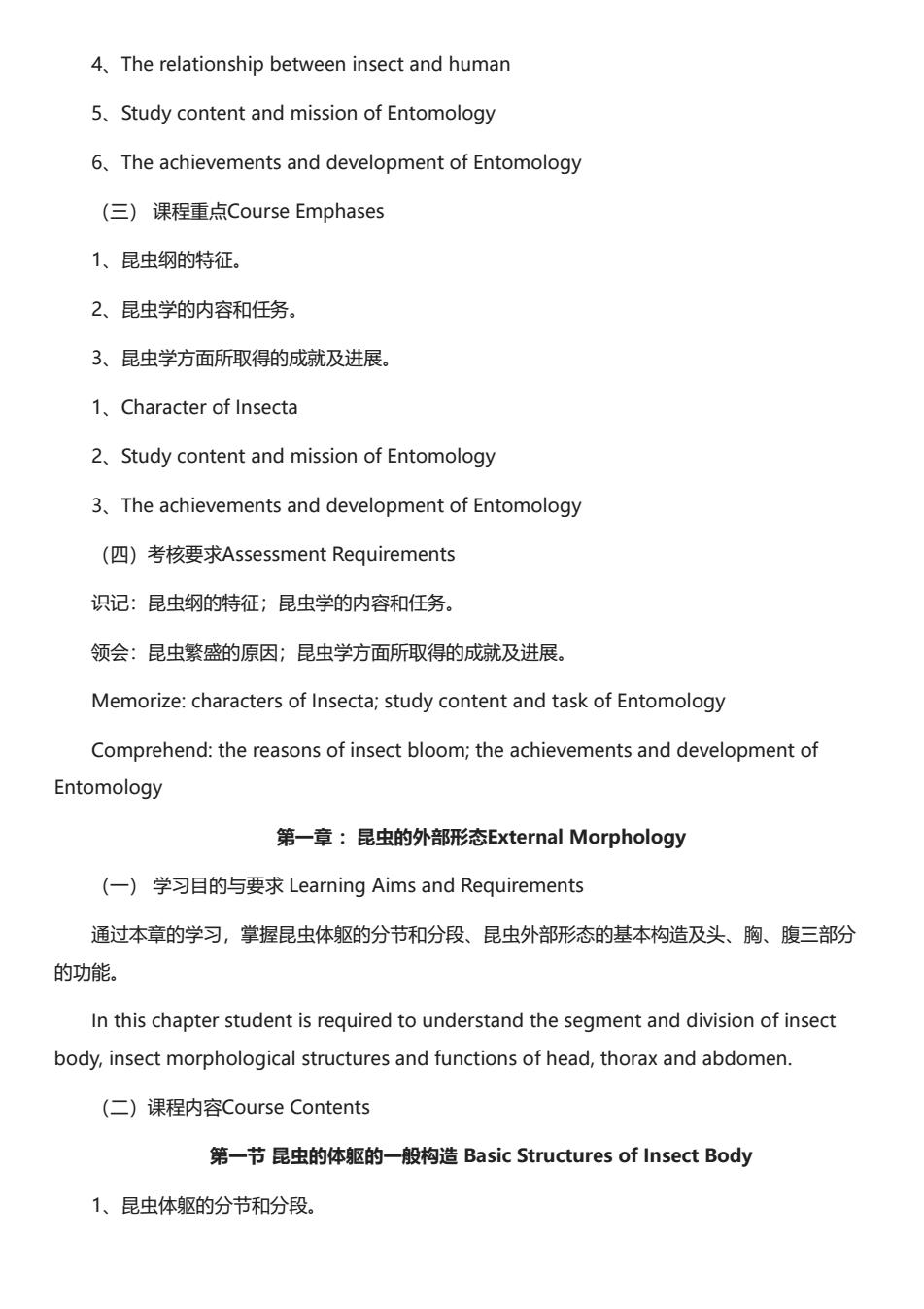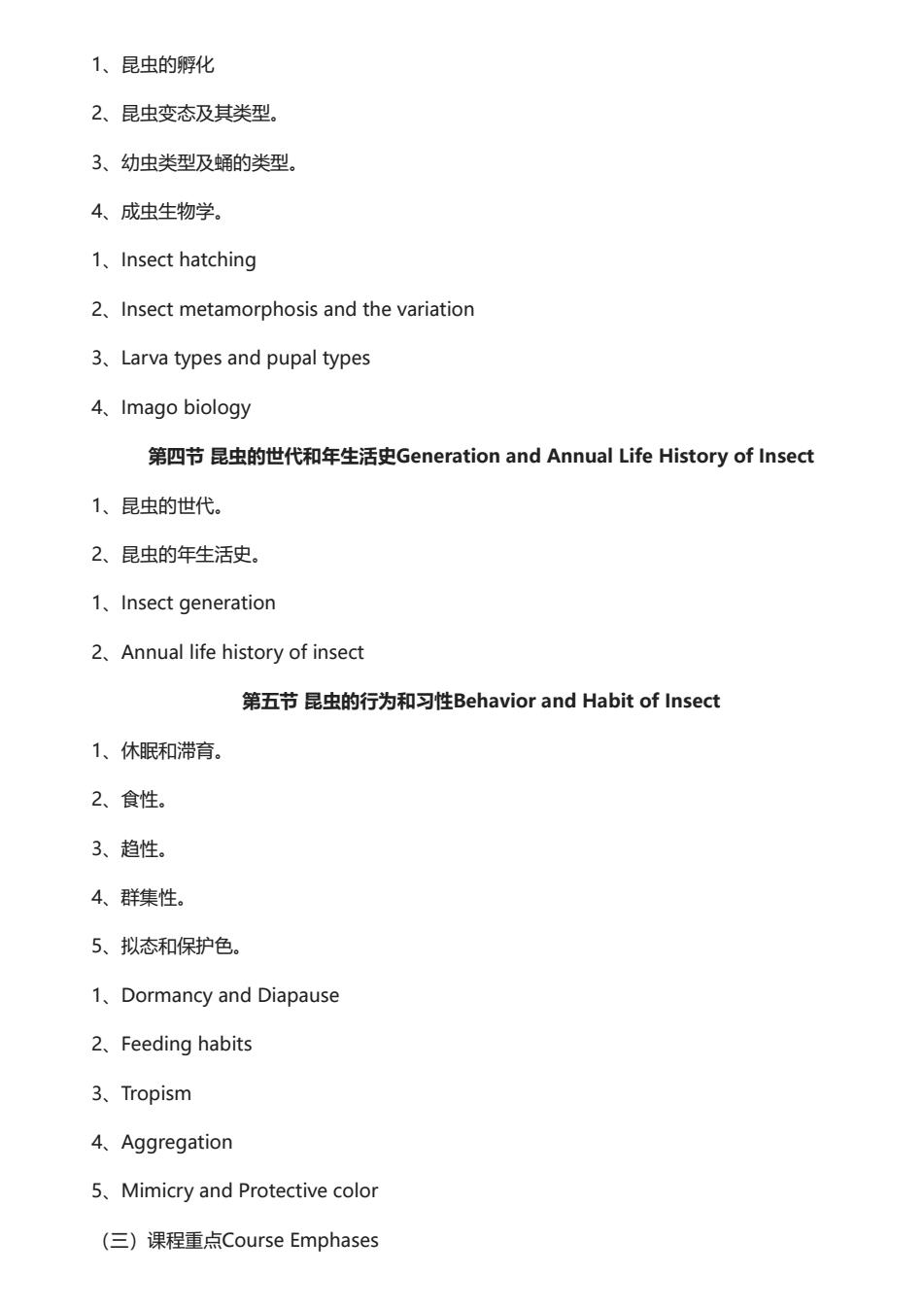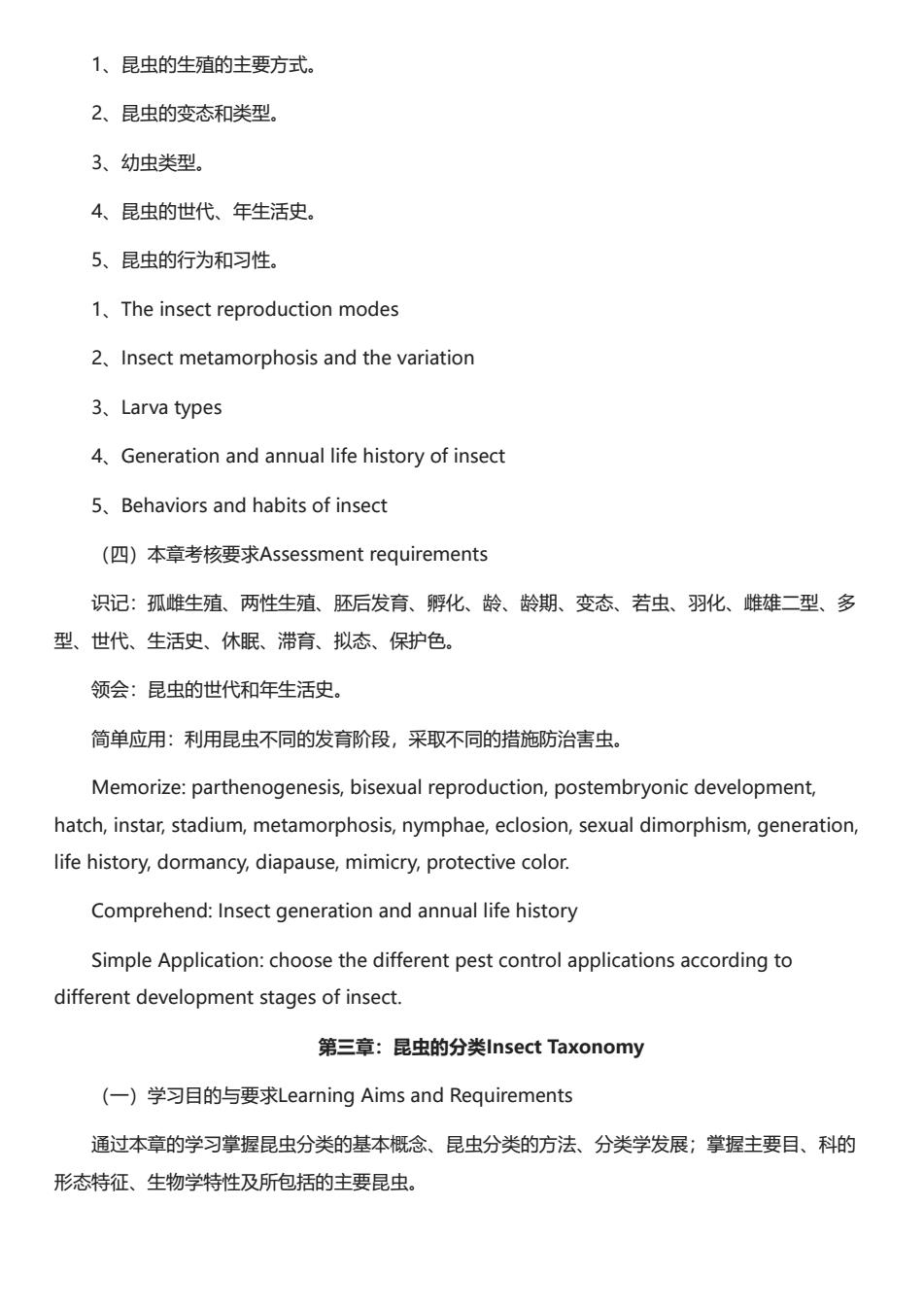
《普通昆虫学》教学大纲 Syllabus of General Entomology 一、课程名称Course Name普通昆虫学General Entomology 二、课程编号Course Serial Number10010117 三、课程的性质、目的与任务Characters,,Objectives and Mission of the Course 普通昆虫学是农学类植保专业的一门必修课,是以昆虫纲为学习、研究对象的课程。设置本课 程的目的是要学生了解昆虫的外部形态结构、生物学特性、分类基本知识、重要目和科的鉴别特 征、内部器官基本构造及生理功能,达到了解昆虫,掌握昆虫特性,为学生从事植物保护工作特别 是害虫综合治理打好基础。 General Entomology is a compulsory course for students who majored in Plant Protection specialty,which is mainly focus on the insect study.The course made students to understand the morphologic structure,biological characteristics,basic knowledge of classification,identification features of important insect orders and families,basic structures and physiological functions of internal organs,all of these are the objective of this course.It is helpful for those students who engaged in plant protection study, especially for integrated pest management. 四、教学的基本要求Basic Requirements of Teaching 要求全面系统地讲授昆虫学的理论,同时加强实验教学,注重以丰富的实验材料,直观的实验 教学,促使理论与实验相结合。注重培养学生的动手能力,激发学生的学习兴趣 Instruct the Entomology theory comprehensively and systematically,at the same time enhance the experimental teaching;through abundant experimental material and visualized experimental work in order to form the combination of theory and experiment. Pay attention to bring up students'practice ability and inspire their learning interests. 五、教学进度安排表Teaching Schedule 讲授时数 实验时数 共计时数 章序Chapter Instruct Time Experiment Time Total Time 绪论Introduction 2 2 12 12 24
《普通昆虫学》教学大纲 Syllabus of General Entomology 一、课程名称 Course Name 普通昆虫学General Entomology 二、课程编号Course Serial Number 10010117 三、课程的性质、目的与任务Characters, Objectives and Mission of the Course 普通昆虫学是农学类植保专业的一门必修课,是以昆虫纲为学习、研究对象的课程。设置本课 程的目的是要学生了解昆虫的外部形态结构、生物学特性、分类基本知识、重要目和科的鉴别特 征、内部器官基本构造及生理功能,达到了解昆虫,掌握昆虫特性,为学生从事植物保护工作特别 是害虫综合治理打好基础。 General Entomology is a compulsory course for students who majored in Plant Protection specialty, which is mainly focus on the insect study. The course made students to understand the morphologic structure, biological characteristics, basic knowledge of classification, identification features of important insect orders and families, basic structures and physiological functions of internal organs, all of these are the objective of this course. It is helpful for those students who engaged in plant protection study, especially for integrated pest management. 四、教学的基本要求Basic Requirements of Teaching 要求全面系统地讲授昆虫学的理论,同时加强实验教学,注重以丰富的实验材料,直观的实验 教学,促使理论与实验相结合。注重培养学生的动手能力,激发学生的学习兴趣。 Instruct the Entomology theory comprehensively and systematically, at the same time enhance the experimental teaching; through abundant experimental material and visualized experimental work in order to form the combination of theory and experiment. Pay attention to bring up students' practice ability and inspire their learning interests. 五、教学进度安排表 Teaching Schedule 章序Chapter 讲授时数 Instruct Time 实验时数 Experiment Time 共计时数 Total Time 绪论Introduction 2 2 一 12 12 24

二 6 3 9 22 30 52 四 14 9 23 五 24 9 33 共计Total 80h 63h 143h 教学实习Teaching 6天days Practice 六、教学内容要点Important Points of Teaching 绪论Introduction (一)学习目的与要求Learning Aims and Requirements 通过本章的学习掌握节肢动物门的基本特征、昆虫纲与其它纲的主要区别;了解昆虫繁盛原 因、昆虫与人类的的关系、昆虫学研究内容和任务、昆虫学研究方面取得的成就及进展。 In this chapter student is required to master the basic characters of arthropod,main differences between insecta and other classes;understand the reason of insect bloom,the relationship between insect and human,study content and mission of Entomology and the achievements and development of Entomology. (二)课程内容Course Contents 1、节肢动物门的基本特征。 2、昆虫纲与中其它纲的主要区别(蛛形纲、甲壳纲、唇足纲、重足纲与昆虫纲)。 3、昆虫繁盛的原因。 4、昆虫与人类的关系。 5、昆虫学的研究内容与任务。 6、昆虫学方面所取得的成就及进展。 1.Basic character of Anthropod 2.Main differences between Insecta and other classes (Arachnida,Crustacea, Chilopoda,Diplopoda and Insecta) 3.The reason of insect bloom
二 6 3 9 三 22 30 52 四 五 14 24 9 9 23 33 共计Total 80 h 63 h 143h 教学实习Teaching Practice 6天 days 六、教学内容要点 Important Points of Teaching 绪论 Introduction (一) 学习目的与要求 Learning Aims and Requirements 通过本章的学习掌握节肢动物门的基本特征、昆虫纲与其它纲的主要区别;了解昆虫繁盛原 因、昆虫与人类的的关系、昆虫学研究内容和任务、昆虫学研究方面取得的成就及进展。 In this chapter student is required to master the basic characters of arthropod, main differences between insecta and other classes; understand the reason of insect bloom, the relationship between insect and human, study content and mission of Entomology and the achievements and development of Entomology. (二) 课程内容Course Contents 1、节肢动物门的基本特征。 2、昆虫纲与中其它纲的主要区别(蛛形纲、甲壳纲、唇足纲、重足纲与昆虫纲)。 3、昆虫繁盛的原因。 4、昆虫与人类的关系。 5、昆虫学的研究内容与任务。 6、昆虫学方面所取得的成就及进展。 1、Basic character of Anthropod 2、Main differences between Insecta and other classes (Arachnida, Crustacea, Chilopoda, Diplopoda and Insecta) 3、The reason of insect bloom

4.The relationship between insect and human 5,Study content and mission of Entomology 6.The achievements and development of Entomology (三)课程重点Course Emphases 1、昆虫纲的特征。 2、昆虫学的内容和任务。 3、昆虫学方面所取得的成就及进展。 1.Character of Insecta 2.Study content and mission of Entomology 3.The achievements and development of Entomology (四)考核要求Assessment Requirements 识记:昆虫纲的特征;昆虫学的内容和任务。 领会:昆虫繁盛的原因;昆虫学方面所取得的成就及进展。 Memorize:characters of Insecta;study content and task of Entomology Comprehend:the reasons of insect bloom;the achievements and development of Entomology 第一章:昆虫的外部形态External Morphology (一)学习目的与要求Learning Aims and Requirements 通过本章的学习,掌握昆虫体躯的分节和分段、昆虫外部形态的基本构造及头、胸、腹三部分 的功能。 In this chapter student is required to understand the segment and division of insect body,insect morphological structures and functions of head,thorax and abdomen. (二)课程内容Course Contents 第一节昆虫的体躯的一般构造Basic Structures of Insect Body 1、昆虫体躯的分节和分段
4、The relationship between insect and human 5、Study content and mission of Entomology 6、The achievements and development of Entomology (三) 课程重点Course Emphases 1、昆虫纲的特征。 2、昆虫学的内容和任务。 3、昆虫学方面所取得的成就及进展。 1、Character of Insecta 2、Study content and mission of Entomology 3、The achievements and development of Entomology (四)考核要求Assessment Requirements 识记:昆虫纲的特征;昆虫学的内容和任务。 领会:昆虫繁盛的原因;昆虫学方面所取得的成就及进展。 Memorize: characters of Insecta; study content and task of Entomology Comprehend: the reasons of insect bloom; the achievements and development of Entomology 第一章 :昆虫的外部形态External Morphology (一) 学习目的与要求 Learning Aims and Requirements 通过本章的学习,掌握昆虫体躯的分节和分段、昆虫外部形态的基本构造及头、胸、腹三部分 的功能。 In this chapter student is required to understand the segment and division of insect body, insect morphological structures and functions of head, thorax and abdomen. (二)课程内容Course Contents 第一节 昆虫的体躯的一般构造 Basic Structures of Insect Body 1、昆虫体躯的分节和分段

2、体区的分节方式。 3、昆虫的附肢。 1.The segments and sections of insect body 2.Modes of body segment 3、Insect appendages 第二节昆虫的头部Insect Head 1、昆虫头部的分节。 2、昆虫头壳的构造及头部内骨骼。 3、昆虫头式类型。 4、触角的基本构造和类型。 5、口器的基本构造和类型。 1.Segment of insect head 2.Structure of Insect head capsule and endoskeleton of head 3、Types of insect head 4.General structures and types of antennae 5.General structuresand types of mouthpart 第三节昆虫的胸部Insect Thorax 1、昆虫胸部的分节和基本构造。 2、昆虫胸部的内骨骼。 3、昆虫足的基本构造和类型。 4、昆虫翅的基本构造和类型及脉序。 1.Segment of insect thorax and its general structures 2.Endoskeleton of insect thorax 3.General structures and types of insect leg 4.General structures,types insect wing and venation
2、体区的分节方式。 3、昆虫的附肢。 1、The segments and sections of insect body 2、Modes of body segment 3、Insect appendages 第二节 昆虫的头部Insect Head 1、昆虫头部的分节。 2、昆虫头壳的构造及头部内骨骼。 3、昆虫头式类型。 4、触角的基本构造和类型。 5、口器的基本构造和类型。 1、Segment of insect head 2、Structure of Insect head capsule and endoskeleton of head 3、Types of insect head 4、General structures and types of antennae 5、General structuresand types of mouthpart 第三节 昆虫的胸部Insect Thorax 1、昆虫胸部的分节和基本构造。 2、昆虫胸部的内骨骼。 3、昆虫足的基本构造和类型。 4、昆虫翅的基本构造和类型及脉序。 1、Segment of insect thorax and its general structures 2、Endoskeleton of insect thorax 3、General structures and types of insect leg 4、General structures, types insect wing and venation

第四节昆虫的腹部Insect Abdomen 1、昆虫腹部的基本构造和分节。 2、昆虫雌雄虫外生殖器官的构造和变化。 3、昆虫腹部的附属器官。 1.Segment of insect abdomen and its general structures 2.Structures and variation of external genitalia of male and female insect 3.Abdominal appendages (三)课程重点Course Emphases 1、昆虫触角的基本构造和类型。 2、昆虫咀嚼式口器和刺吸式口器在构造上的区别。 3、昆虫足的基本构造和类型。 4、翅的基本构造和类型及脉序。 5、昆虫雌雄虫外生殖器官的基本构造。 1.Basic structures and types of antennae 2.The structural differences between chewing mouthpart and sucking mouthparts 3.General structures and types of insect leg 4.General structures,types insect wing and venation 5.General structures and variation of external genitalia of male and female insect (四)本章考核要求Assess Requirements 识记:初生分节、后生分节、内骨骼、附肢、幕骨、悬骨、翅脉、脉序。 领会:昆虫体躯的基本构造;昆虫咀嚼式口器和刺吸式口器在构造上的区别;昆虫足的基本构 造;昆虫头、胸、腹三部的功能。 简单应用:在田间如何鉴别咀嚼式口器和刺吸式口器的为害特征? Memorize:primary segmentation,secondary segmentation,endoskeleton,appendage, tentorium,phragma,vein,venation
第四节 昆虫的腹部Insect Abdomen 1、昆虫腹部的基本构造和分节。 2、昆虫雌雄虫外生殖器官的构造和变化。 3、昆虫腹部的附属器官。 1、Segment of insect abdomen and its general structures 2、Structures and variation of external genitalia of male and female insect 3、Abdominal appendages (三) 课程重点Course Emphases 1、昆虫触角的基本构造和类型。 2、昆虫咀嚼式口器和刺吸式口器在构造上的区别。 3、昆虫足的基本构造和类型。 4、翅的基本构造和类型及脉序。 5、昆虫雌雄虫外生殖器官的基本构造。 1、Basic structures and types of antennae 2、The structural differences between chewing mouthpart and sucking mouthparts 3、General structures and types of insect leg 4、General structures, types insect wing and venation 5、General structures and variation of external genitalia of male and female insect (四) 本章考核要求Assess Requirements 识记:初生分节、后生分节、内骨骼、附肢、幕骨、悬骨、翅脉、脉序。 领会:昆虫体躯的基本构造;昆虫咀嚼式口器和刺吸式口器在构造上的区别;昆虫足的基本构 造;昆虫头、胸、腹三部的功能。 简单应用:在田间如何鉴别咀嚼式口器和刺吸式口器的为害特征? Memorize: primary segmentation, secondary segmentation, endoskeleton, appendage, tentorium, phragma, vein, venation

Comprehend:insect morphological structures,the morphological differences between chewing mouthparts and sucking mouthparts of insect,general structures and types of insect leg,functions of head,thorax and abdomen. Simple Application:How to distinguish the harmful characters of chewing mouthpart and sucking mouthparts? 第二章:昆虫生物学Insect Biology (一)学习目的与要求Learning Aims and Requirements 通过本章的学习,掌握昆虫的生殖方式;昆虫的胚胎发育、胚后发育;成虫生物学;昆虫的世 代和年生活史;昆虫的行为和习性。 In this chapter student is required to master the insect reproduction modes,embryonic and postembryonic development,imago biology,generation and annual life history of insect,behaviors and habits of insect. (二)课程内容Course Contents 第一节昆虫的生殖方式Insect Reproduction Mode 1、两性生殖和孤雌生殖。 2、多胚生殖。 3、胎生和幼体生殖。 1.Bisexual reproduction and parthenogenesis 2、Polyembryony 3.Viviparity and paedogenesis 第二节昆虫卵和胚胎发育Insect Egg and Embryonic Development 1、卵的基本构造,卵的类型和产卵方式。 2、胚胎发育过程。 1.General structures of egg,types of egg and mode of laying eggs 2.Process of embryonic development 第三节昆虫的胚后发育Postembryonic Development
Comprehend: insect morphological structures, the morphological differences between chewing mouthparts and sucking mouthparts of insect, general structures and types of insect leg, functions of head, thorax and abdomen. Simple Application: How to distinguish the harmful characters of chewing mouthpart and sucking mouthparts? 第二章 :昆虫生物学Insect Biology (一)学习目的与要求Learning Aims and Requirements 通过本章的学习, 掌握昆虫的生殖方式;昆虫的胚胎发育、胚后发育;成虫生物学;昆虫的世 代和年生活史;昆虫的行为和习性。 In this chapter student is required to master the insect reproduction modes, embryonic and postembryonic development, imago biology, generation and annual life history of insect, behaviors and habits of insect. (二)课程内容Course Contents 第一节 昆虫的生殖方式Insect Reproduction Mode 1、两性生殖和孤雌生殖。 2、多胚生殖。 3、胎生和幼体生殖。 1、Bisexual reproduction and parthenogenesis 2、Polyembryony 3、Viviparity and paedogenesis 第二节 昆虫卵和胚胎发育Insect Egg and Embryonic Development 1、卵的基本构造,卵的类型和产卵方式。 2、胚胎发育过程。 1、General structures of egg, types of egg and mode of laying eggs 2、Process of embryonic development 第三节 昆虫的胚后发育Postembryonic Development

1、昆虫的孵化 2、昆虫变态及其类型。 3、幼虫类型及蛹的类型。 4、成虫生物学。 1、Insect hatching 2.Insect metamorphosis and the variation 3.Larva types and pupal types 4、Imago biology 第四节昆虫的世代和年生话史Generation and Annual Life History of Insect 1、昆虫的世代。 2、昆虫的年生活史。 1、Insect generation 2.Annual life history of insect 第五节昆虫的行为和习性Behavior and Habit of Insect 1、休眠和滞育。 2、食性。 3、趋性。 4、群集性。 5、拟态和保护色。 1.Dormancy and Diapause 2、Feeding habits 3、Tropism 4、Aggregation 5.Mimicry and Protective color (三)课程重点Course Emphases
1、昆虫的孵化 2、昆虫变态及其类型。 3、幼虫类型及蛹的类型。 4、成虫生物学。 1、Insect hatching 2、Insect metamorphosis and the variation 3、Larva types and pupal types 4、Imago biology 第四节 昆虫的世代和年生活史Generation and Annual Life History of Insect 1、昆虫的世代。 2、昆虫的年生活史。 1、Insect generation 2、Annual life history of insect 第五节 昆虫的行为和习性Behavior and Habit of Insect 1、休眠和滞育。 2、食性。 3、趋性。 4、群集性。 5、拟态和保护色。 1、Dormancy and Diapause 2、Feeding habits 3、Tropism 4、Aggregation 5、Mimicry and Protective color (三)课程重点Course Emphases

1、昆虫的生殖的主要方式。 2、昆虫的变态和类型。 3、幼虫类型。 4、昆虫的世代、年生活史。 5、昆虫的行为和习性。 1.The insect reproduction modes 2.Insect metamorphosis and the variation 3、Larva types 4.Generation and annual life history of insect 5,Behaviors and habits of insect (四)本章考核要求Assessment requirements 识记:孤雌生殖、两性生殖、胚后发育、孵化、龄、龄期、变态、若虫、羽化、雌雄二型、多 型、世代、生活史、休眠、滞育、拟态、保护色。 领会:昆虫的世代和年生活史。 简单应用:利用昆虫不同的发育阶段,采取不同的措施防治害虫。 Memorize:parthenogenesis,bisexual reproduction,postembryonic development, hatch,instar,stadium,metamorphosis,nymphae,eclosion,sexual dimorphism,generation, life history,dormancy,diapause,mimicry,protective color. Comprehend:Insect generation and annual life history Simple Application:choose the different pest control applications according to different development stages of insect. 第三章:昆虫的分类Insect Taxonomy (一)学习目的与要求Learning Aims and Requirements 通过本章的学习掌握昆虫分类的基本概念、昆虫分类的方法、分类学发展;掌握主要目、科的 形态特征、生物学特性及所包括的主要昆虫
1、昆虫的生殖的主要方式。 2、昆虫的变态和类型。 3、幼虫类型。 4、昆虫的世代、年生活史。 5、昆虫的行为和习性。 1、The insect reproduction modes 2、Insect metamorphosis and the variation 3、Larva types 4、Generation and annual life history of insect 5、Behaviors and habits of insect (四)本章考核要求Assessment requirements 识记:孤雌生殖、两性生殖、胚后发育、孵化、龄、龄期、变态、若虫、羽化、雌雄二型、多 型、世代、生活史、休眠、滞育、拟态、保护色。 领会:昆虫的世代和年生活史。 简单应用:利用昆虫不同的发育阶段,采取不同的措施防治害虫。 Memorize: parthenogenesis, bisexual reproduction, postembryonic development, hatch, instar, stadium, metamorphosis, nymphae, eclosion, sexual dimorphism, generation, life history, dormancy, diapause, mimicry, protective color. Comprehend: Insect generation and annual life history Simple Application: choose the different pest control applications according to different development stages of insect. 第三章:昆虫的分类Insect Taxonomy (一)学习目的与要求Learning Aims and Requirements 通过本章的学习掌握昆虫分类的基本概念、昆虫分类的方法、分类学发展;掌握主要目、科的 形态特征、生物学特性及所包括的主要昆虫

In this chapter student is required to master the basic conception of insect classification,methods of insect classification,development of classification,morphological characters of major classes and order,biological characters and major insects. (二)课程内容Course Contents 第一节昆虫分类学概述Insect Taxonomy Summary 1、分类阶元和种的概念。 2、昆虫的命名方法和规则。 3、分类检索表。 4、昆虫分类学展望。 1.Taxonomic category and specific concept 2.Nomenclature and regulation of insect 3、Systematic key 4.Prospect of Insect taxonomy 第二节昆虫纲的分目Orders of Insecta 1、昆虫纲的分类体系。 2、昆虫纲各小目形态特征,生物学意义及变态类型。 1.Insect classification system 2.Morphological characters of minor insect orders,biology and types of metamorphism of them. 第三节农业昆虫中的重要目Important Insect Orders in Agriculture 1、直翅目成虫的形态特征,生物学特性,分类及重要科的简介。 2、同翅目成虫的形态特征,生物学特性,分类及重要科的简介。 3、半翅目成虫的形态特征,生物学特性,分类及重要科的简介。 4、鞘翅目成虫及幼虫的形态特征,生物学特性,分类及重要科的简介。 5、鳞翅目成虫及幼虫的形态特征,生物学特性,分类及重要科的简介
In this chapter student is required to master the basic conception of insect classification, methods of insect classification, development of classification, morphological characters of major classes and order, biological characters and major insects. (二)课程内容Course Contents 第一节 昆虫分类学概述Insect Taxonomy Summary 1、分类阶元和种的概念。 2、昆虫的命名方法和规则。 3、分类检索表。 4、昆虫分类学展望。 1、Taxonomic category and specific concept 2、Nomenclature and regulation of insect 3、Systematic key 4、Prospect of Insect taxonomy 第二节 昆虫纲的分目Orders of Insecta 1、昆虫纲的分类体系。 2、昆虫纲各小目形态特征,生物学意义及变态类型。 1、Insect classification system 2、Morphological characters of minor insect orders, biology and types of metamorphism of them. 第三节 农业昆虫中的重要目Important Insect Orders in Agriculture 1、直翅目成虫的形态特征,生物学特性,分类及重要科的简介。 2、同翅目成虫的形态特征,生物学特性,分类及重要科的简介。 3、半翅目成虫的形态特征,生物学特性,分类及重要科的简介。 4、鞘翅目成虫及幼虫的形态特征,生物学特性,分类及重要科的简介。 5、鳞翅目成虫及幼虫的形态特征,生物学特性,分类及重要科的简介

6、膜翅成虫的形态特征,生物学特性,分类及重要科的简介。 7、双翅目成虫的形态特征,生物学特性,分类及重要科的简介 1.Morphological and biological characters of Orthoptera imago,classification and introduction of major families 2.Morphological and biological characters of Homoptera imago,classification and introduction of major families 3.Morphological and biological characters of Hemiptera imago,classification and introduction of major families 4.Morphological and biological characters of Coleoptera imago and larval, classification and introduction of major families 5.Morphological and biological characters of Lepidoptera imago and larval, classification and introduction of major families 6,Morphological and biological characters of Hymenoptera imago,classification and introduction of major families 7 Morphological and biological characters of Diptera imago,classification and introduction of major families (三)课程重点Course Emphases 1、掌握昆虫分类基本概念、基本方法、。 2、掌握分类检索表。 3、掌握主要目、科的形态特征、生物学特性。 1.Basic conception and methods of insect taxonomy 2、Systematic keys 3.Morphological and biological characters of major orders and families (四)本章考核要求Assessment Requirements 识记:种、亚种、学名、同名、异名、双名法、三名法、模式标本、正模、副模、配模。 领会:农业昆虫中重要目生物学特性及变态类型、主要科的形态特征
6、膜翅目成虫的形态特征,生物学特性,分类及重要科的简介。 7、双翅目成虫的形态特征,生物学特性,分类及重要科的简介 1、Morphological and biological characters of Orthoptera imago, classification and introduction of major families 2、Morphological and biological characters of Homoptera imago, classification and introduction of major families 3、Morphological and biological characters of Hemiptera imago, classification and introduction of major families 4、Morphological and biological characters of Coleoptera imago and larval, classification and introduction of major families 5、Morphological and biological characters of Lepidoptera imago and larval, classification and introduction of major families 6、Morphological and biological characters of Hymenoptera imago, classification and introduction of major families 7、Morphological and biological characters of Diptera imago, classification and introduction of major families (三)课程重点Course Emphases 1、掌握昆虫分类基本概念、基本方法、。 2、掌握分类检索表。 3、掌握主要目、科的形态特征、生物学特性。 1、Basic conception and methods of insect taxonomy 2、Systematic keys 3、Morphological and biological characters of major orders and families (四)本章考核要求Assessment Requirements 识记:种、亚种 、学名、同名、异名、双名法、三名法、模式标本、正模、副模、配模。 领会:农业昆虫中重要目生物学特性及变态类型、主要科的形态特征